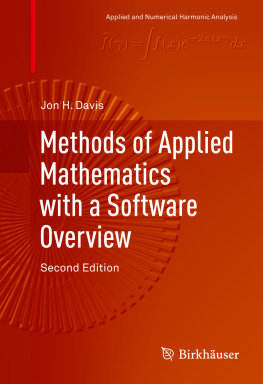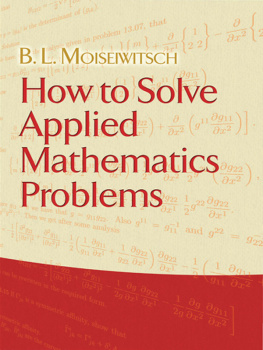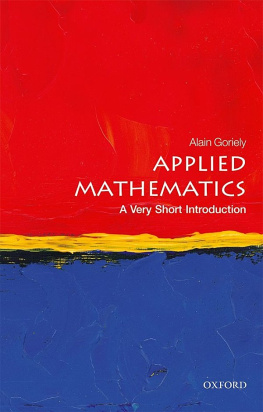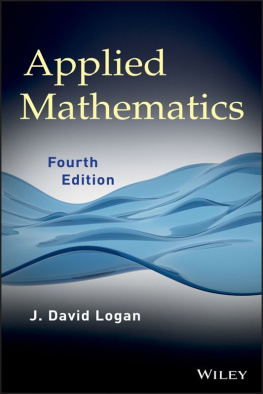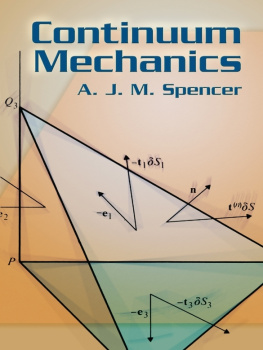Applied Mathematics for Engineers and Physicists
Third Edition
Louis A. Pipes and
Lawrence R. Harvill
DOVER PUBLICATIONS, INC.
M INEOLA , N EW Y ORK
Copyright Copyright 1946, 1958, 1970 by Louis A. Pipes and Lawrence R. Harvill Copyright 1998 by Johanna I. Pipes and Lawrence R.
Harvill Preface to the Dover Edition copyright 2014 by Lawrence R. Harvill All rights reserved. Bibliographical Note This Dover edition, first published in 2014, is an unabridged republication of the work originally published by the McGraw-Hill Book Company, New York, in 1970. Lawrence R. Harvill has prepared a new Preface specially for this Dover edition. Library of Congress Cataloging-in-Publication Data Pipes, Louis Albert, 1910 author.
Applied mathematics for engineers and physicists / Louis A. Pipes and Lawrence R. Harvill. Third edition. pages cm Reprint of: 3rd. ed.
New York : McGraw-Hill, [1970]. eISBN-13: 978-0-486-79499-0 1. Mathematical physics. 2. Mechanics, Applied. I.
Harvill, Lawrence R., 1935 author. II. Title. QA401.P5 2014 510.2453dc23 2013043789 Manufactured in the United States by Courier Corporation
77951301 2014
www.doverpublications.com
PREFACE TO THE DOVER EDITION
This book represents the reprinting of the third edition of
Applied Mathematics for Engineers and Physicists, originally published in 1970 as part of the
International Series in Pure and Applied Mathematics. The first edition was published in 1946 and the second in 1958, both by the primary author, Louis A. Pipes.
It is one of three major texts for engineers and physicists with the other two being Advanced Engineering Mathematics by Erwin Kreyszig and Mathematics of Physics and Modern Engineering by Ivar Stephen Sokolnikoff and Raymond M. Redheffer. Louis or Louie as he was called by his friends and colleagues was a quintessential professor and avid student of the applications of mathematics to a wide variety of problems. In addition to his scholarly research he was a consultant for the Aerospace Corporation in Redondo Beach, CA and the Naval Weapons Center in Ridgecrest, CA. In the classroom Louie was an amazingly effective teacher with an exceptional memory of all the primary literature in the area he was presenting. Hardly a lecture would go by without a reference to a story about a humorous event or a quote by the author whom he was presenting.
His lectures were so clear and logical, that it was easy to be lulled into a false sense of security, feeling that one fully understood the subject. After class, one quickly realized that taking good notes was the only way to avoid extra hours struggling to work out the homework. Louie also had a great sense of humor. Sometimes during a lecture when a student asked a question that was slightly off, Louie would stare at the student and his face would assume a questioning scowl; he would then reach into his coat pocket and pull out a cap pistol and fire at the stunned student. The scowl would dissolve into a smile and after the gales of laughter subsided; he would go about a careful explanation of the point the student had missed. After completing my PhD under Louies guidance I accepted a faculty position in engineering at the University of Redlands in 1964.
Shortly thereafter Louie asked me to coauthor this third edition, which initiated a long period of close collaboration and enjoyable tennis matches until the work was published in 1970. It was later translated into a four volume Japanese edition. Throughout my 34-year career of teaching at the University of Redlands I always tried to model my teaching after Louies exceptional style and obvious great enthusiasm for the subject at hand. L. HARVILL, PHD, PE Redlands, CA, 2014
PREFACE
The first edition of this text was published 23 years ago and the second edition 11 years ago. It was stated in the Preface to the second edition that the tremendous development of high-speed computing devices was a major factor guiding the changes and revisions presented in that edition.
The developments which have come about in digital computers since the publication of the second edition have been all the more spectacular. Computation speeds and memory size have increased by two orders of magnitude during this period, while machine costs have dropped by an order of magnitude. A single modern center, such as the Western Data Processing Center at the University of California at Los Angeles, has as much computing capacity today as all the combined installations in the United States a decade ago. There is also no apparent reason why one should not expect these trends to continue over the next decade. Another factor to be considered is the recent development of time-sharing computer systems which, through large numbers of remote terminals, provide engineers and scientists with direct and immediate access to a computer for problem solving. It may not be too long until the remote terminal has replaced the slide rule as a readily available and sophisticated computing tool.
As a result the analyst will be spending more time on developing realistic mathematical models for a physical problem and less time on the computational details. Also, the magnitude of the computations are of lesser concern because of the great speed of digital machines. However, computers have not eliminated the problem of choosing between accuracy and speed; they have only shifted the break-even point to a higher level. We would like to suggest two particular areas of concern which we feel should be reviewed from time to time by every analyst. The first is to maintain an awareness of the limitations of any mathematical model resulting from the various approximations imposed during the modeling process. This is very important in order to avoid predicting the behavior of a system by a solution obtained from a model based on postulates which are invalid in the region of interest.
Our second concern is that even though computers have given us the ability to study complex models, we should not stop seeking simpler representations, as it is an easy matter to overcomplicate a problem. Perhaps the greatest factor creating the need for the extensive changes included in this third edition has been the widespread changes in engineering curricula which will continue for several years to come. Coupled with this are improvements in teaching mathematics at the high school level, which have enabled the shifting of more advanced material into the lower-division mathematics sequences in many colleges. These two situations have increased the mathematics requirements for engineering students and raised the level of mathematical rigor. The authors feel that both of these situations are desirable, but it was decided not to trade off the valuable physical applications for increased rigor in this edition. It is felt that most instructors teaching an advanced course based on this text can easily add any desired amount of rigor during the lectures but that it is usually more difficult to add a wide range of physical applications during the lecture period.
Those readers who are familiar with the previous two editions of this book will rapidly become aware of the extensive changes which have been made in this third edition. The arrangement of the chapters has been changed greatly, with those on series, special functions, vectors and tensors, transcendental equations, and partial differentiation being moved to appendixes. This change is an attempt to make the material more flexible for the variety of courses in which this book could be employed as a text. Since the material in the body of the text is designed for use in a one-year course, it is hoped that each instructor will feel free to add from, or exchange with, the material in the appendixes to meet the level and individual requirements of his course. Other changes are the combining of the two previous tables of Laplace transforms into a single one in . Fourier, Hankel, and Mellin transforms have been added to the chapter on operational methods, and a new chapter on statistics and probability has been included.




